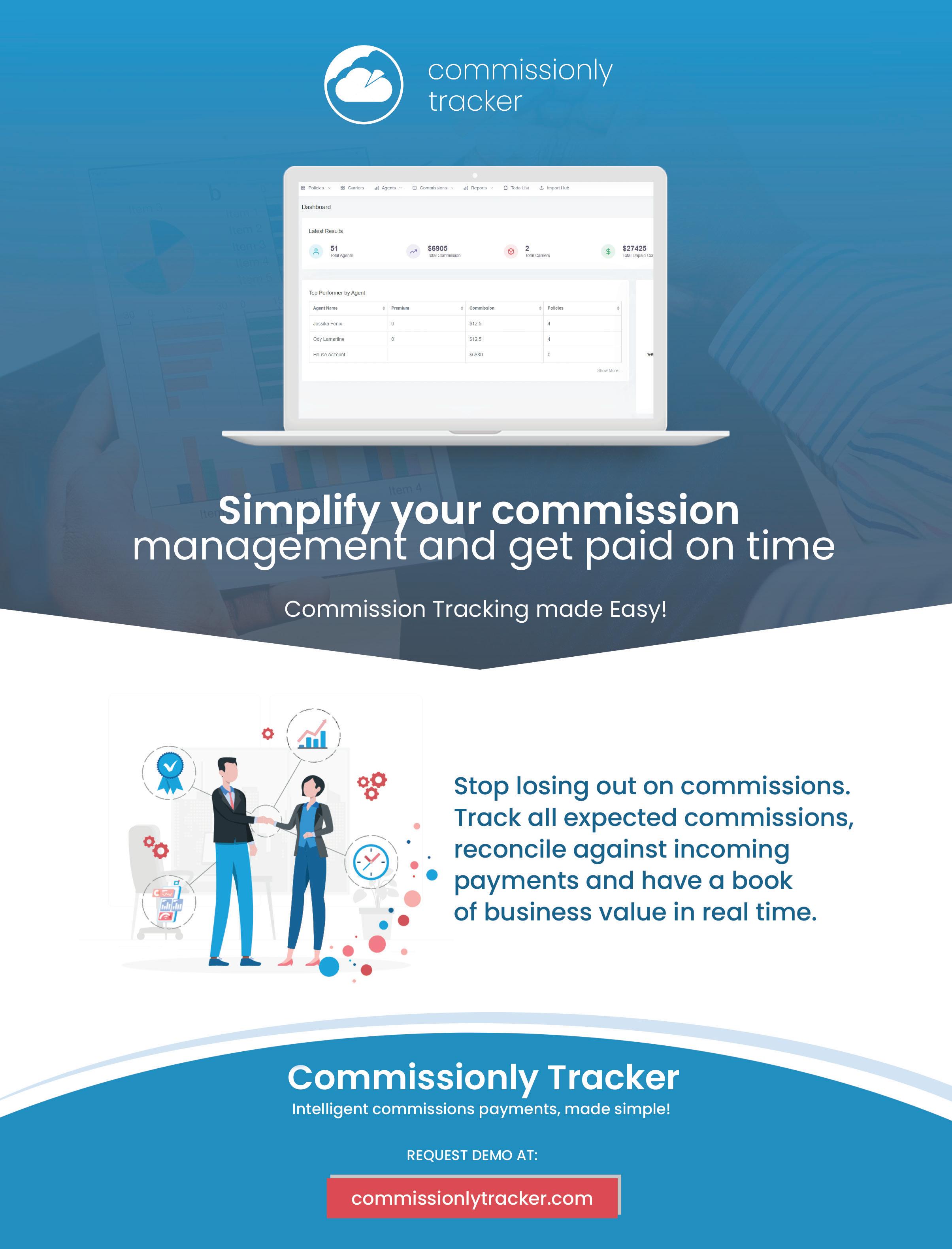
10 minute read
Why advisors historically underuse RILAs in planning
Although increased market volatility has spiked a rise in registered index-linked annuity sales, RILAs are complex products that are still relatively new.
By David Hanzlik
Introduced to the market in 2010, registered index-linked annuities are long-term savings products that limit risk exposure and provide tax-deferred growth potential.
RILAs are often viewed as a mix between a fixed indexed annuity and a variable annuity because they have greater
growth potential than a fixed indexed annuity but lower potential return and risk than a variable annuity. RILAs are a great asset to any retirement portfolio because they offer flexibility through customizable risk exposure and the greatest potential for growth of any risk-managed product.
Although increased market volatility driven by global events such as the pandemic has spiked a rise in the market share of RILAs, they are complex and still relatively new, representing only about a quarter of overall annuity sales. Further education of advisors by wholesalers on RILAs will ensure that concerns about costs and other misconceptions are cleared up and that advisors can provide their clients with the best tools possible to set them up for success.
Another factor that historically has limited the growth of RILAs is how new
they are. Most financial advisors are over the age of 50. For these advisors, RILAs have existed for only a small portion of their career. Sticking to the tried-and-true methods when advising a client on how to
RILA 2Q sales were up 5% to $10.5 billion.
In the first half of 2022, RILA sales were $20.1 billion, 5% higher than in the prior year.
(SOURCE: LIMRA’s U.S. Individual Annuity Sales Survey) invest their money is understandable. But especially in times of financial insecurity, not providing investors with a complete picture of the products available has limited the growth of RILAs and general awareness of their benefits.
Annuities provide the financial stability that many Americans so desperately need by allowing tax-deferred growth and offering the option to have a guaranteed source of income in retirement. But there is a wide range of annuity products available, each with its own unique characteristics. Fixed indexed annuities present the lowest risk to investors but are usually overlooked due to the low growth potential that comes with this level of exposure.
At the other end of the spectrum are variable annuities, which, in these volatile times, offer a level of risk many investors do not have the financial security to afford. RILAs strike a balance between risk and return that makes them the perfect product for 2022.
While still underused products, RILAs have dramatically increased in popularity over the past two years. According to the Secure Retirement Institute, total 2020 sales of RILAs were estimated to be at $24.1 billion (as of December 2020, final figures pending), up 38.5% over 2019 sales of $17.4 billion. Sales in 2019 were up 55% from 2018, and the forecast indicates continued growth in the area.
Expected sales growth
As more people become aware of the benefits of RILAs and understand why they are so attractive during times of volatility, there is an expectation that the growth in sales will continue. In fact, LIMRA expects RILA sales to grow as much as 50% this year, and the RILA market, which now makes up one-fourth of all variable annuities sold, to expand through 2025.
CUNA Mutual Group was the third organization to offer RILAs in 2013, and in recent years, they have started to become a major driver of growth for the organization. In March, we had our best month ever of annuities sales, and RILAs now represent 90% of CUNA Mutual Group’s 2021 deposits and 70% of our assets under management.
Another reason for the continued growth in RILA sales and annuities overall is the increase in average life expectancy. People need their savings to stretch further and last longer to accommodate an extended retirement often filled with rising health care costs. What’s more, a decline in defined benefit plans has left people without the safety nets that they have grown accustomed to. The combination of growth potential and risk protections that RILAs offer is ideal for many who are grappling with the financial issues that come with aging, such as the fear of outliving their retirement savings.
Since the market uncertainty is likely to continue in the coming years, there must be an industry shift in the narrative, not
just around RILAS but also around annuities as a whole. For many, a guaranteed income product is a key pillar in a sustainable retirement plan.
People in general are not good at thinking beyond the short term, and when you take that into consideration, along with the current uncertainty of international affairs, rising inflation and the drastic shift away from defined benefit plans, it’s clear that not enough people are thinking beyond immediate accumulation.
To combat the gap between need and preparedness, the advisor industry could benefit from an industrywide, legislation-savvy consortium of experts who understand products and regulation and can advocate for constructive solutions.
Despite the resistance from some advisors, RILAs will continue to increase in popularity in the coming years. Recently introduced legislation that would make it easier for Americans to understand and access them could further accelerate their rise. It is up to the industry to communicate their benefits to all advisors, especially younger ones, who might be more open to expanding their offerings and educating Americans on the benefits of guaranteed income in retirement. This will ensure that people have the knowledge and access they need to build a secure financial future.
David Hanzlik is vice president of annuity and retirement solutions at CUNA Mutual Group. He may be contacted at david.hanzlik@innfeedback.com.
If your clients are looking for accumulation or guaranteed income, look to American Equity for a solution.
Accumulation Guaranteed Income


AssetShield FIXED INDEX ANNUITY • Competitive Participation Rates1 • 5, 7, 103 year surrender charge schedule available • Multiple 1-and 2-year crediting strategies • Selection of 5 index allocation options
IncomeShield FIXED INDEX ANNUITY • 7% Premium Bonus2 • 5 Lifetime Income Benefit Rider Options • 7 and 103 year surrender charge schedule available
Annuities and Rider issued under form series ICC17 BASE-IDX, ICC17 IDX-10-5, ICC17 IDX-10-7, ICC17 IDX-10-10, ICC18 E-PTPC, ICC18 E-MPTP, ICC18 E-PTPR, ICC18 E-MPTP-A (Patent Pending), ICC16 R-MVA, ICC18 R-WSC, ICC17 BASEIDX-B, ICC17 IDX-11-10, ICC17 R-LIBR-FCP, ICC17 R-LIBR-FSP, ICC17 R-LIBR-W-FCP, ICC17 R-LIBR-W-FSP and state variations thereof. Availability may vary by state. LIBR with Wellbeing Benefit not available in California or Delaware. This material is for informational purposes only, and is not a recommendation to buy, sell, hold or rollover any asset. It does not take into account the specific financial circumstances, investment objectives, risk tolerance, or need of any specific person. In providing this information American Equity Investment Life Insurance Company is not acting as your fiduciary as defined by the Department of Labor. American Equity does not offer legal, investment or tax advice or make recommendations regarding insurance or investment products. Please consult a qualified professional. Guarantees are based on the financial strength and claims paying ability of American Equity and are not guaranteed by any bank or insured by the FDIC. Other retirement options may also support similar goals. ¹Participation rate is set at issue and subject to change. 2Bonus available on IncomeShield 10 1st year premiums. Each year after the 1st contract year, you become vested in a percentage of the bonus, until 100% vested at the end of the 10th contract year. Vested amounts of the bonus are the amounts not forfeited as a result of an early withdrawal or surrender. Bonus, surrender charges, and vesting schedules may vary by state. See brochure and ® disclosure for details. 39 year surrender charge in California. 6000 Westown Pkwy, West Des Moines, IA 50266 01AD-INN-MAG1022 10.03.22 www.american-equity.com ● Call us at 888-221-1234
TM
AMERICAN EQUITY
INVESTMENT LIFE INSURANCE COMPANY
Increase in U.S. Health Care Plan Costs from 2021 to 2022
Employer health care costs expected to jump in 2023
Plan Cost* 2021 2022 Change from 2021 to 2022
Employer Cost $10,123 $10,500 +3.7%
Employee Premiums from Paychecks $2,504 $2,520 +0.6%
Employers are expected to dig deeper into Total Plan Cost $12,627 $13,020 +3.1% their pockets to cover their employees’ health care in 2023, according to Aon. The average costs that U.S. employers will pay for their employees’ health care is projected to increase 6.5% to more than $13,800 per employee in 2023.
This projection is more than double the 3% increase to health care budgets that employers experienced from 2021 to 2022, but is significantly below the 9.1% inflation figure reported through the Consumer Price Index.
Aon said this jump reflects the trend of workers postponing or skipping many medical procedures during the first year of the COVID-19 pandemic. Employers have seen the medical claims experience return to more typical levels of growth and anticipate inflation will put more pressure on costs next year.
Meanwhile, workers also ponied up more for health care in 2022 than they did in 2021, although not as much. Aon said. The amount of premiums deducted from employee paychecks was about 0.6% more in 2022 than it was in 2021. But workers were on the hook for a higher percentage of out-of-pocket costs between 2021 and 2022. Employee out-of-pocket costs rose an average 5.2% from 2021 to 2022 — from an average of $1,798 in 2021 to an average of $1,892 in 2022.
ACA PLANS OFTEN DENY IN-NETWORK CLAIMS
The rate of uninsured Americans is declining, and that’s largely because of the Affordable Care Act and the expansion of Medicaid in many states. But having health insurance doesn’t always mean the care you need will be covered, KFF found.
KFF analyzed data on claims denials and appeals on ACA marketplace plans for 2020 and found in-network claims are denied about 18% of the time.
About 16% of denials were because the claim was for an excluded service. Ten percent were denied due to a lack of preauthorization or referral. Only about 2% were denied based on lack of medical necessity. Most denials — 72% — were classified as “all other reasons” without a specific reason.
Nationwide, some insurers deny claims at rates of less than 1%, while others are as high as 80%, KFF said.


CANCER TOP DRIVER OF EMPLOYER HEALTH COSTS
Cancer toppled musculoskeletal conditions as the top driver of large companies’ health care costs, according to the Business Group on Health’s 2023 Large Employers’ Health Care Strategy and Plan Design Survey.
The top three conditions fueling health care costs remained the same from last year – cardiovascular disease, cancer and musculoskeletal conditions. However, 13% of
employers said they have seen more late-stage cancers, and another 44% anticipate seeing such an increase in the future, likely due to pandemic-related delays in care.
Another survey finding revealed that nearly all large employers (99%) said they were concerned about prescription drug trends. In 2021, prescription drugs accounted for a median of 21% of employers’ health care costs, with more than half of pharmacy spending going to specialty medications.
QUOTABLE
Counties with larger non-Hispanic Black populations tend to have fewer participating insurance carriers.”
— Maanasa Kona, assistant research professor, Georgetown University McCourt School of Public Policy
NAVIGATOR SPENDING HITS RECORD HIGH
The Affordable Care Act’s navigator program saw a record funding boost for the 2023 open enrollment period. The U.S.
Department of Health and Human
Services is sending $98.9 million in grant funding to 59 navigator organizations for the upcoming open enrollment period.
The funding will enable navigator organizations to retain staff and add to the more than 1,500 existing navigators, HHS said.
This marks the single largest navigator funding award provided
to date and continues historic levels of funding under the Biden administration. The administration previously gave $80 million to the program, quadrupling the number of navigators for the 2022 open enrollment period.
DID YOU KNOW ?
Amazon will close its Amazon Care telehealth unit at the end of the year.








